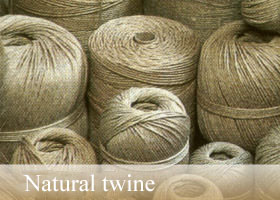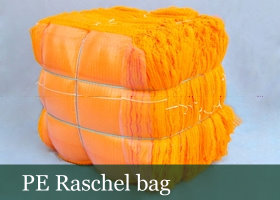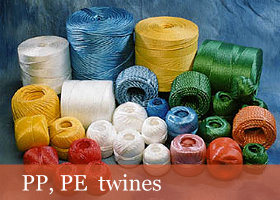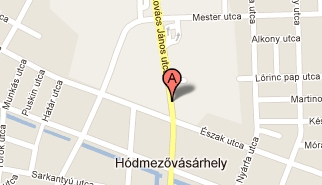Hemp processing
Harvesting
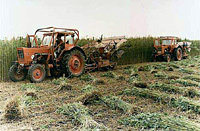 Industrial hemp gives best harvesting result when planted into soils rich in minerals, adobe or clay based soils are the best to cultivate. Sowing should be around the second half of April in 3-4 centimeters deep into the soil. Industrial hemp is ready for harvesting when its pollen is ripe, and is being blown away by the wind. This is the period, when the fibers are not so coarse, the solidity and fineness is most appropriate for processing. The plants are harvested by a specially designed harvesting machine, which after cutting down the green plant, places it in the form of bundles on the field, which are then bound together. After appropriate time of drying, the bundles are put into cones to provide further drying environment, when the plant looses its green color.
Industrial hemp gives best harvesting result when planted into soils rich in minerals, adobe or clay based soils are the best to cultivate. Sowing should be around the second half of April in 3-4 centimeters deep into the soil. Industrial hemp is ready for harvesting when its pollen is ripe, and is being blown away by the wind. This is the period, when the fibers are not so coarse, the solidity and fineness is most appropriate for processing. The plants are harvested by a specially designed harvesting machine, which after cutting down the green plant, places it in the form of bundles on the field, which are then bound together. After appropriate time of drying, the bundles are put into cones to provide further drying environment, when the plant looses its green color.
Retting
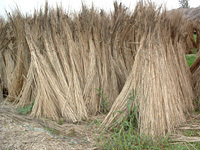 The connection between the bast fibers and the woody core is loosened by microorganisms after adding appropriate amount of water. The bales are therefore placed into pools, where the retting process takes place, after adding certain amount of water and pressing the bundles down for the required extent. The water utilized at this phase is natural thermal water, with appropriate temperature, sufficient oxygen, iron and additional mineral content, which is altogether ideal for the microorganisms. As a result, the bast fiber is separated from the core of the plant, the connection between different parts of the plant is loosened. The retting water is then let down, the bundles are placed in the forms of cones on the drying area.
The connection between the bast fibers and the woody core is loosened by microorganisms after adding appropriate amount of water. The bales are therefore placed into pools, where the retting process takes place, after adding certain amount of water and pressing the bundles down for the required extent. The water utilized at this phase is natural thermal water, with appropriate temperature, sufficient oxygen, iron and additional mineral content, which is altogether ideal for the microorganisms. As a result, the bast fiber is separated from the core of the plant, the connection between different parts of the plant is loosened. The retting water is then let down, the bundles are placed in the forms of cones on the drying area.
Drying
In further treatment of the plant, it is essential to lower the rate of humidity to 12-16%. This is the required state of the material when it can be processed, and also it can be stored for longer periods of time, in which case the plants are then tied into bundles and put together in stacks. For the drying of the fibers, the sunny, windy and dry weather conditions are above all necessary.
Fiber production
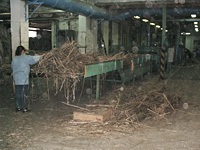 The aim of the mechanical exploration of hemp fibers is to separate as much as possible the flexible fiber part and the solid core portion of the plant. By strong, lengthwise impact the plant is cut into stripes, and by the effect of crosswise force, the core is crushed. By further technological steps, the pulp still adhering is separated form the hemp fibers, the coarser stock part is cut from the fibers. The phase of hackling arranges the fibers into parallel order, it also separates the bundles into individual fibers.
The aim of the mechanical exploration of hemp fibers is to separate as much as possible the flexible fiber part and the solid core portion of the plant. By strong, lengthwise impact the plant is cut into stripes, and by the effect of crosswise force, the core is crushed. By further technological steps, the pulp still adhering is separated form the hemp fibers, the coarser stock part is cut from the fibers. The phase of hackling arranges the fibers into parallel order, it also separates the bundles into individual fibers.
Pre-carding
This phase is to prepare the fibers for the carding process, it decomposes the fibers with pulp pieces, creates bands and rolls after softening the base material. The needles at this preliminary phase are longer the rollers are also bigger, than in those used at the carting machine. The machine processes homogeneous material.
Fine-carding
The machine does the purification, cleaning and carting of the fiber, it produces consistent bands of parallel fibers, which is than applicable for further treatment. Pre-carting and Fine-carting are technologies only used when creating tow-yarns.
Stretching
The aim of the process is to make the bands thinner, more consistent while parallel and pure fibers are created. The stretching machine prepares the material for yarn making, by streching and mixing the rolls received from the fine carting phase.
Spinning
The machine creates clean, consistent yarns of infinite length from the slightly polluted, tangled fibers created after the stretching phase. The band is created after measuring the purity, which after twisting gets a consistent structure and finally the yarn is rolled up.
Doubling
A thread consist of two or more yarns twisted together. The aim of production is to create a material that has higher breaking strength and is more consistent than yarns. The friction between the yarns is greater, but the breaking strength of the thread has a higher value than the amount of individual yarns’ breaking strength, the quality of the product is therefore upgraded. When working with six yarns in creating threads, the yarns are mixed in several steps, so the end-product is a complex thread.
Polishing
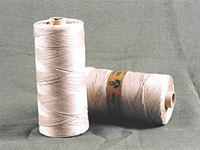 Twines are created from hemp threads or from a single hemp yarn, that has smooth and shiny surface, which is achieved by utilizing starch and an additional paraffin wax treatment. Twines, according to users’ demands can be manufactured by using fiber or tow-yarn based threads. From fiber-yarn, the product created has higher consistency and high value of breaking strength, the surface is smooth and soft, for special purposes and utilization in either thin or thick form. Twines are usually made by spinning two or three threads together, but the spinning of four, five or six threads is also possible, in which cases thinner yarns are used.
Twines are created from hemp threads or from a single hemp yarn, that has smooth and shiny surface, which is achieved by utilizing starch and an additional paraffin wax treatment. Twines, according to users’ demands can be manufactured by using fiber or tow-yarn based threads. From fiber-yarn, the product created has higher consistency and high value of breaking strength, the surface is smooth and soft, for special purposes and utilization in either thin or thick form. Twines are usually made by spinning two or three threads together, but the spinning of four, five or six threads is also possible, in which cases thinner yarns are used.
Packing
The twines are most commonly packed in balls, but the form of cheese, hank, is also possible, as well as twines cut into exact lengths and than packed in bales. The most common mass of balls are 50, 200 and 500 grams, and for industrial uses the most common mass of cheese can be up to 3,5 kilograms.
Rope making
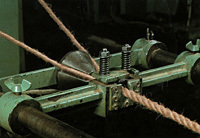 The structure of ropes are similar to that of the twines: the strands are given a pre-torsion, so the loss of total torsion is evaded. Products above 5 millimeters are usually called rope, each strand is composed of the appropriate number of yarns and given the necessary rate of torsion. Ropes are usually made of 3 or 4 strands.
The structure of ropes are similar to that of the twines: the strands are given a pre-torsion, so the loss of total torsion is evaded. Products above 5 millimeters are usually called rope, each strand is composed of the appropriate number of yarns and given the necessary rate of torsion. Ropes are usually made of 3 or 4 strands.





